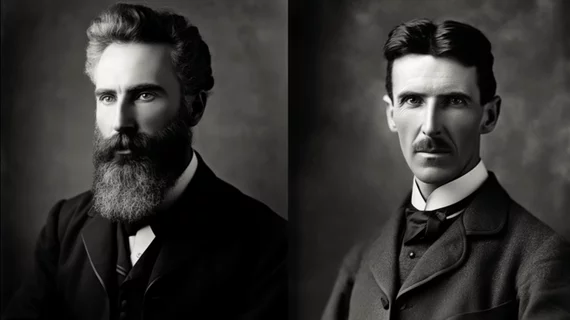Generative AI 'reincarnates' famous physicists in radiology
Since generative artificial intelligence products first emerged, the models’ capabilities have grown by leaps and bounds. Now, they can seemingly bring renowned scientists from the past back to life.
In a new paper in Cureus, co-authors Ramin Javan, MD, with the Department of Radiology at George Washington University School of Medicine and Health Sciences, and Navid Mostahgni, from California University of Science and Medicine, detail how they were able to use different generative AI applications to “reincarnate” deceased physicists whose work was influential in the field of radiology—Wilhelm Conrad Roentgen, Nikola Tesla, Marie and Pierre Curie, Albert Einstein, and Christian Doppler.
“AI-powered multimedia generation technologies, particularly video synthesis through stable diffusion and transformers, offer transformative potential for radiology education, communication, and visualization," the authors explained. “Potential applications in radiology include improving and speeding up medical 3D visualization, as well as enhancing educational content, information delivery, patient interactions, and teleconsultations.”
Using image-to-image generation, the duo was able to generate 440 images of the scientists through 110 prompts. Similarly, they deployed image-to-video generation tactics to create 22 videos of the physicists working, plus text-to-voice applications to create two videos showcasing voice cloning techniques.
Some of the photos generated can be viewed in the gallery below (click the photo to view the full image):
The final results were not perfect and several of the finished products required adjustments for lip, mouth, and head movements. The authors acknowledged issues that still plague generative AI, such as the quality, consistency and reliability of the content it produces.
Additionally, there are still major concerns among the public about the use of AI.
“Perhaps the biggest concern with AI-generated media is the potential for misinformation, fraud, and misinterpretation, highlighting the immense amount of effort required by the industry and governments to ensure safe and responsible use,” the authors wrote, adding that issues of copyright and consent could also pose ethical and legal challenges.
While the images and videos the team was able to create highlight great promise, there is also much room for improvement in generative AI applications, and many questions need to be answered before it can be of clinical or educational benefit, the authors noted.
“As these technologies rapidly evolve, we anticipate significant advancements that will address current limitations and unlock new possibilities. However, it is crucial to approach these developments carefully, considering ethical implications and responsible use through continued interdisciplinary collaboration among radiologists, AI researchers, and ethicists, ultimately enhancing medical education and improving patient care.”
The videos and all other media the authors produced using generative AI applications can be viewed here.




